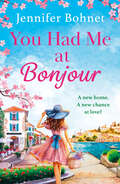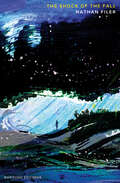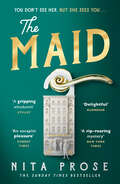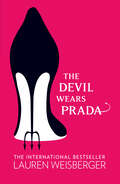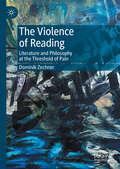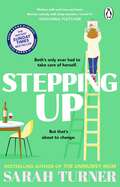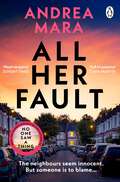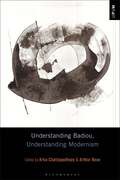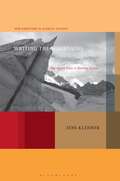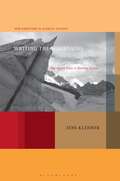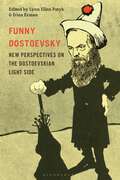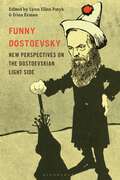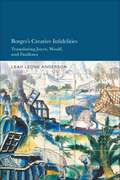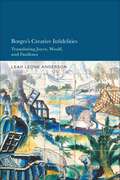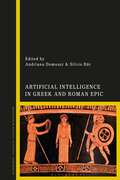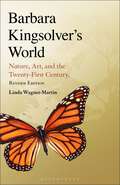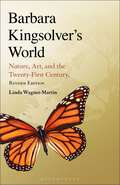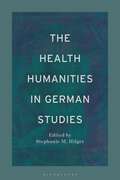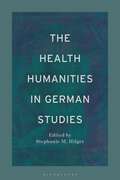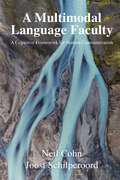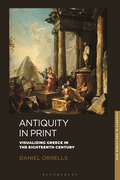- Table View
- List View
You Had Me At Bonjour
by null Jennifer BohnetNew year, Nouveau Jessica! If you’d asked Jessica a year ago, she would have told you that her life was pretty near perfect. But one year – and one very messy divorce – later, she’s not so sure. Which is how she found herself boarding a plane to the south of France, determined to put her past behind her… preferably via some deliciously chilled rosé. Meeting a new man was never part of the plan. Yet when she meets Nino, her new neighbour’s impossibly sexy nephew, steering clear of romance seems easier said than done. Suddenly, Jessica finds herself right back where she started: with her heart on the line. But now she’s made a new start, perhaps it’s time for Jessica to throw caution to the wind, take a few risks… and learn to regrette rien! Readers LOVE You Had Me At Bonjour! ‘This is a fun, easy to read book… I fell in love with her new life in Provence and loved the subtle little snippets of life in France… I was sad to leave!’ Reader review, ⭐ ⭐ ⭐ ⭐ ⭐ ‘Enjoyable read… Makes you wish you could run away to Cannes! Hard to put down once you start reading.’ Reader review, ⭐ ⭐ ⭐ ⭐ ⭐ ‘This is just one of those feel-good novels… It was fun going on Jessica's belated gap year with her!’ Reader review, ⭐ ⭐ ⭐ ⭐ ⭐ ‘There can't be many women who haven't wanted to get away from it all at times, and Jennifer Bohnet's heroine had the courage to do it. I loved the diary format, and Jennifer Bohnet's overall writing style… [An] excellently crafted story that helps us get away from it all in our heads if not in reality. I look forward to her next book very much indeed.’ Reader review, ⭐ ⭐ ⭐ ⭐ ⭐
The Shock of the Fall
by null Nathan FilerWINNER OF THE COSTA BOOK OF THE YEAR 2013 WINNER OF THE SPECSAVERS POPULAR FICTION BOOK OF THE YEAR 2014 WINNER OF THE BETTY TRASK PRIZE 2014 ‘I’ll tell you what happened because it will be a good way to introduce my brother. His name’s Simon. I think you’re going to like him. I really do. But in a couple of pages he’ll be dead. And he was never the same after that.’ There are books you can’t stop reading, which keep you up all night. There are books which let us into the hidden parts of life and make them vividly real. There are books which, because of the sheer skill with which every word is chosen, linger in your mind for days. The Shock of the Fall is all of these books. The Shock of the Fall is an extraordinary portrait of a young man’s descent into mental illness. It is a brave and groundbreaking novel from one of the most exciting new voices in fiction. –––––––––––––––––––––––––- ‘A stunning novel. Ambitious and exquisitely realised, it's by turns shocking, harrowing and heartrending. The writing is so accomplished it's hard to believe it's a debut – it's clearly the work of a major new talent' S J WATSON ‘Nathan Filer is following in the footsteps of Mark Haddon’s genre-setting The Curious Incident Of The Dog In The Night-Time. Both funny and painful… you’re going to love it’ DAILY MAIL ‘Bittersweet and wonderfully etched…perceptive and moving’ TELEGRAPH ‘A deeply moving (but also funny) first novel’ Kate Saunders, THE TIMES ‘A compelling story of grief, madness and loss. Filer has an ear for the dark comedy of life, and Matthew is a charismatic lead character who draws you in even as his world falls apart’ OBSERVER MAGAZINE ‘A tragic and comic account of living with schizophrenia. A must for fans of Matthew Quick’s The Silver Linings Playbook’ GQ
The Maid (A Molly the Maid mystery #1)
by null Nita Prose*Molly the maid returns in THE MYSTERY GUEST – available to buy now!* _________________________________________________________________ Curl up with the million-copy bestseller . . . *THE NO.1 NEW YORK TIMES & SUNDAY TIMES TOP TEN BESTSELLER*WINNER OF THE GOODREADS CHOICE AWARD FOR BEST MYSTERY/THRILLER*WINNER OF THE NED KELLY AWARD FOR BEST INTERNATIONAL CRIME FICTION*A BBC RADIO 4 BOOK AT BEDTIME PICK ‘An escapist pleasure’ SUNDAY TIMES‘An instantly gripping whodunnit’ STYLIST‘Smart, riveting, and deliciously refreshing ’ LISA JEWELL_________________________________________________________________ It begins like any other day for Molly Gray, silently dusting her way through the luxury rooms at the Regency Grand Hotel. But when she enters suite 401 and discovers an infamous guest dead in his bed, a very messy mystery begins to unfold. And Molly’s at the heart of it – because if anyone can uncover the secrets beneath the surface, the fingerprints amongst the filth – it’s the maid . . . _______________________________________________________ Everyone’s getting swept away by The Maid: ‘Excellent and totally entertaining . . . the most interesting (and endearing) main character in a long time’ STEPHEN KING ‘This is phenomenal thriller. Maid or murderer or victim? Find out in the book’ READER REVIEW ⭐⭐⭐⭐⭐ ‘Gripping, deftly written, and led by a truly unforgettable protagonist in Molly. I'm recommending it to everyone I know' EMMA STONEX ‘I loved everything about this book’ READER REVIEW ⭐⭐⭐⭐⭐ ‘I didn’t think I could love a character any more than I loved Eleanor Oliphant but along comes Molly the Maid. God, I love her’ READER REVIEW ⭐⭐⭐⭐⭐ ‘Fresh, fiendish and darkly beguiling. The Maid is so thrillingly original, and clever, and joyous. I just adored every page’ CHRIS WHITAKER ‘Felt like a modern day homage to Agatha Christie’ READER REVIEW ⭐⭐⭐⭐⭐ ‘Lots of twists and turns and highly gripping’ READER REVIEW ⭐⭐⭐⭐⭐ A Sunday Times No.4 bestseller for w/c 24/01/2022 A New York Times No.1 bestseller for w/c 31/01/2022
The Devil Wears Prada: Loved the movie? Read the book! (The\devil Wears Prada Ser. #Book 1)
by null Lauren WeisbergerThe classic bestseller – over a million copies sold worldwide! Soon to be a West End musical, written by Elton John and starring Vanessa Williams … High fashion, low cunning – and the boss from hell. When Andrea first sets foot in the plush Manhattan offices of Runway she knows nothing. She's never heard of the world's most fashionable magazine, or its feared and fawned-over editor, Miranda Priestly – her new boss. A year later, she knows altogether too much: That it's a sacking offence to wear anything lower than a three-inch heel to work. That you can charge cars, manicures, anything at all to the Runway account, but you must never, ever, leave your desk, or let Miranda's coffee get cold. And that at 3 a.m. on a Sunday, when your boyfriend's dumping you because you're always at work, if Miranda phones, you jump. But this is Andrea’s big break – it's going to be worth it in the end. Isn't it?
The Violence of Reading: Literature and Philosophy at the Threshold of Pain
by Dominik ZechnerThe Violence of Reading: Literature and Philosophy at the Threshold of Pain expounds the scene of reading as one that produces an overwhelmed body exposed to uncontainable forms of violence. The book argues that the act of reading induces a representational instability that causes the referential function of language to collapse. This breakdown releases a type of “linguistic pain” (Scarry; Butler; Hamacher) that indicates a constitutive wounding of the reading body. The wound of language marks a rupture between linguistic reality and the phenomenal world. Exploring this rupture in various ways, the book brings together texts and genres from diverse traditions and offers close examinations of the rhetoric of masochism (Sacher-Masoch; Deleuze), the relation between reading and abuse (Nietzsche; Proust; Jelinek), the sublime experience of reading (Kant; Kafka; de Man), the “novel of the institution” (Musil; Campe), and literary suicide (Bachmann; Berryman; Okkervil River).
Stepping Up: The joyful and emotional Sunday Times bestseller and Richard and Judy Book Club pick. Adored by readers
by Sarah Turner**Featured on BBC Radio 4 A Good Read**'Written with such love and heart. Sarah has done an exceptional job of marrying her trademark comedy with deep and raw emotion. I loved it!' GIOVANNA FLETCHERFROM THE SUNDAY TIMES BESTSELLING AUTHOR OF THE UNMUMSY MUMBeth has never stuck at anything.She's quit more jobs and relationships than she can remember and she still sleeps in her childhood bedroom. It's not that she hasn't tried to grow up, it's just that so far, the only commitment she's held down is Friday drinks at the village pub. Then, in the space of a morning, her world changes. An unspeakable tragedy turns Beth's life upside down, and she finds herself guardian to her teenage niece and toddler nephew, catapulted into an unfamiliar world of bedtime stories, parents' evenings and cuddly elephants. Having never been responsible for anyone - or anything - it's not long before she feels seriously out of her depth. What if she's simply not up to the job?With a little help from her best friend Jory (purely platonic, of course ...) and her lovely, lonely next-door neighbour, Albert, Beth is determined that this time she's not giving up. It's time to step up. This is a story about digging deep for strength you never knew you had and finding magic in things that were there all along. 'STEPPING UP is a heart-blasting triumph of a novel - wise, witty and wonderfully human.' Isabelle Broom'Stop EVERYTHING and read this! Funny, tender and beautifully observed. Loved, loved, LOVED it!' Cathy Bramley'A moving and beautifully-told tale of parenthood but not as you know it. I just loved it.' Gillian McAllisterEarly readers love STEPPING UP!***** 'Simply excellent . . . A true emotional rollercoaster.'***** 'It had me laughing out loud, on a bus no less, crying and laughing. This book is a tonic! I read it in one go. I was rooting for Beth the whole way through!!'***** 'An emotional rollercoaster to keep you turning the pages. . .Perfect for curling up with; perfect for a bedtime read; perfect for a book group; just perfect.'***** 'This book needs all the stars! It made me laugh, it made me cry and I just want to start it all over again.'***** 'Funny, heartbreaking and totally relatable, it makes you feel all the feels!'
All Her Fault: The breathlessly twisty Sunday Times bestseller everyone is talking about
by Andrea Mara**Shortlisted for Crime Fiction Book of the Year at the An Post Irish Book Awards 2021**'A heart-stopping tale . . . Stunningly original' Sunday Times Crime Book of the Month'Grips from the first page and keeps upping the stakes . . . I didn't predict any of the twists and turns.' Sarah Pearse, bestselling author of The SanatoriumONE MISSING BOY.Marissa Irvine arrives at 14 Tudor Grove, expecting to pick up her young son Milo from his first playdate with a boy at his new school. But the woman who answers the door isn't a mother she recognises. She isn't the nanny. She doesn't have Milo. And so begins every parent's worst nightmare.FOUR GUILTY WOMEN.As news of the disappearance filters through the quiet Dublin suburb and an unexpected suspect is named, whispers start to spread about the women most closely connected to the shocking event. Because only one of them may have taken Milo - but they could all be blamed . . .IN A COMMUNITY FULL OF SECRETS, WHO IS REALLY AT FAULT?'Sharp, sophisticated, and full of suspense - everything you need for a perfect summer read.' Cara Hunter, bestselling author of Close to Home'Andrea Mara's tight plotting and convincing characterisation make her books both compelling and intriguing.' Liz Nugent, author of Lying in Wait'A wonderfully twisty nightmare of a domestic thriller.' Emma Curtis, author of Keep Her Quiet'A cracking read from a writer at the top of her game - and wow . . . that twist floored me!' Claire Allan, author of Her Name Was Rose'Someone has taken Marissa's child; the fun in this fiendishly twisting narrative is trying to work out who that might be.' Irish IndependentEveryone is gossiping about All Her Fault:'WOW WOW WOW! I have not read a book this thrilling in ages' ⭐ ⭐ ⭐ ⭐ ⭐'So many twists and turns, and what a shock at the end' ⭐ ⭐ ⭐ ⭐ ⭐'This is one of the best thriller books I have read this year . . . I was totally blown away' ⭐ ⭐ ⭐ ⭐ ⭐'You must read this book' ⭐ ⭐ ⭐ ⭐ ⭐'The final chapter is the perfect payoff' ⭐ ⭐ ⭐ ⭐ ⭐'A great twisty read that kept me on the edge of my seat' ⭐ ⭐ ⭐ ⭐ ⭐PRE-ORDER Someone in the Attic, the unputdownable new thriller from No.1 Sunday Times bestselling author Andrea Mara
Understanding Badiou, Understanding Modernism (Understanding Philosophy, Understanding Modernism)
by Arka Chattopadhyay and Arthur RoseIn his philosophical project, aesthetic orientation and political leanings, Alain Badiou is a product of, and a leading advocate for, European modernism. From the milieu of May 1968 to the contemporary 'postmodern' ethos, Badiou returns, time and again, to avant-garde modernist texts – aesthetic, political, philosophical and scientific – as inspiration for his response to present situations. Drawing upon disciplines as varied as architecture, cinema, theatre, music, history, mathematics, poetry and philosophy, Understanding Badiou, Understanding Modernism shows how Badiou's contribution to philosophy must be understood within the context of his decades-long conversation with modernist thinking. As with other volumes in the series, Understanding Badiou, Understanding Modernism follows a three part structure. The first section explores Badiou's readings of aesthetic, political and scientific modernities; both introducing his system and pointing to how Badiou offers manifold readings of modernism. The middle portion of the book connects Badiou's thought with the various strands of aesthetic, philosophical, amorous and political modernisms in relation to which it can be extended. The final section is a glossary of key concepts and categories that Badiou uses in his interface with modernism.
Understanding Badiou, Understanding Modernism (Understanding Philosophy, Understanding Modernism)
In his philosophical project, aesthetic orientation and political leanings, Alain Badiou is a product of, and a leading advocate for, European modernism. From the milieu of May 1968 to the contemporary 'postmodern' ethos, Badiou returns, time and again, to avant-garde modernist texts – aesthetic, political, philosophical and scientific – as inspiration for his response to present situations. Drawing upon disciplines as varied as architecture, cinema, theatre, music, history, mathematics, poetry and philosophy, Understanding Badiou, Understanding Modernism shows how Badiou's contribution to philosophy must be understood within the context of his decades-long conversation with modernist thinking. As with other volumes in the series, Understanding Badiou, Understanding Modernism follows a three part structure. The first section explores Badiou's readings of aesthetic, political and scientific modernities; both introducing his system and pointing to how Badiou offers manifold readings of modernism. The middle portion of the book connects Badiou's thought with the various strands of aesthetic, philosophical, amorous and political modernisms in relation to which it can be extended. The final section is a glossary of key concepts and categories that Badiou uses in his interface with modernism.
Writing the Mountains: The Alpine Form in German Fiction (New Directions in German Studies)
by Professor or Dr. Jens KlennerWriting the Mountains reconsiders the role of mountains in German language fiction from 1800 to the present and argues that in a range of texts, from E.T.A. Hoffmann's “Die Bergwerke zu Falun” (1819) to Elfriede Jelinek's Die Kinder der Toten (1995) and beyond, mountains serve as dynamic spaces of material change that generate aesthetic and narrative innovation. In contrast to dominant critical approaches to the Alpine landscape in literature, in which mountain ranges often features as passive settings, or which trace the influence of geographical and geological sciences in literary productions, this study argues for the dynamic role in literature of presumably rigid mineral structures.In German-language fiction after 1800, the counter-intuitive topology of rocky mountain ranges and unfathomable subterranean depths of the Alpine imaginary functions as a space of exception which appears to reconfirm and radically challenge the foundations of Enlightenment thought. Writing the Mountains reads the mountain range as a rigid yet permeable liminal space. Within this zone, semiotic orders are unsettled, as is the division between organic and inorganic, between the human and the other.
Writing the Mountains: The Alpine Form in German Fiction (New Directions in German Studies)
by Professor or Dr. Jens KlennerWriting the Mountains reconsiders the role of mountains in German language fiction from 1800 to the present and argues that in a range of texts, from E.T.A. Hoffmann's “Die Bergwerke zu Falun” (1819) to Elfriede Jelinek's Die Kinder der Toten (1995) and beyond, mountains serve as dynamic spaces of material change that generate aesthetic and narrative innovation. In contrast to dominant critical approaches to the Alpine landscape in literature, in which mountain ranges often features as passive settings, or which trace the influence of geographical and geological sciences in literary productions, this study argues for the dynamic role in literature of presumably rigid mineral structures.In German-language fiction after 1800, the counter-intuitive topology of rocky mountain ranges and unfathomable subterranean depths of the Alpine imaginary functions as a space of exception which appears to reconfirm and radically challenge the foundations of Enlightenment thought. Writing the Mountains reads the mountain range as a rigid yet permeable liminal space. Within this zone, semiotic orders are unsettled, as is the division between organic and inorganic, between the human and the other.
Funny Dostoevsky: New Perspectives on the Dostoevskian Light Side
Tapping into the emergence of scholarly comedy studies since the 2000s, this collection brings new perspectives to bear on the Dostoevskian light side. Funny Dostoevksy demonstrates how and why Dostoevsky is one of the most humorous 19th-century authors, even as he plumbs the depths of the human psyche and the darkest facets of European modernity. The authors go beyond the more traditional categories of humor, such as satire, parody, and the carnivalesque, to apply unique lenses to their readings of Dostoevsky. These include cinematic slapstick and the body in Crime and Punishment, the affective turn and hilarious (and deadly) impatience in Demons, and ontological jokes in Notes from Underground and The Idiot. The authors – (coincidentally?) all women, including some of the most established scholars in the field alongside up-and-comers – address gender and the marginalization of comedy, culminating in a chapter on Dostoevsky's "funny and furious" women, and explore the intersections of gender and humor in literary and culture studies. Funny Dostoevksy applies some of the latest findings on humor and laughter to his writing, while comparative chapters bring Dostoevsky's humor into conjunction with other popular works, such as Chaplin's Modern Times and Lin-Manuel Miranda's Hamilton. Written with a verve and wit that Dostoevsky would appreciate, this boldly original volume illuminates how humor and comedy in his works operate as vehicles of deconstruction, pleasure, play, and transcendence.
Funny Dostoevsky: New Perspectives on the Dostoevskian Light Side
by Lynn Ellen Patyk and Irina ErmanTapping into the emergence of scholarly comedy studies since the 2000s, this collection brings new perspectives to bear on the Dostoevskian light side. Funny Dostoevksy demonstrates how and why Dostoevsky is one of the most humorous 19th-century authors, even as he plumbs the depths of the human psyche and the darkest facets of European modernity. The authors go beyond the more traditional categories of humor, such as satire, parody, and the carnivalesque, to apply unique lenses to their readings of Dostoevsky. These include cinematic slapstick and the body in Crime and Punishment, the affective turn and hilarious (and deadly) impatience in Demons, and ontological jokes in Notes from Underground and The Idiot. The authors – (coincidentally?) all women, including some of the most established scholars in the field alongside up-and-comers – address gender and the marginalization of comedy, culminating in a chapter on Dostoevsky's "funny and furious" women, and explore the intersections of gender and humor in literary and culture studies. Funny Dostoevksy applies some of the latest findings on humor and laughter to his writing, while comparative chapters bring Dostoevsky's humor into conjunction with other popular works, such as Chaplin's Modern Times and Lin-Manuel Miranda's Hamilton. Written with a verve and wit that Dostoevsky would appreciate, this boldly original volume illuminates how humor and comedy in his works operate as vehicles of deconstruction, pleasure, play, and transcendence.
Borges's Creative Infidelities: Translating Joyce, Woolf and Faulkner
by Dr. Leah Leone AndersonUsing comparative analyses of source and target texts, Leone Anderson examines Jorge Luis Borges's residual presence in his Spanish-language translations of works by James Joyce, Virginia Woolf, and William Faulkner.Argentine writer and critic Jorge Luis Borges did not see translation as an inferior form of artistic production to be defined primarily in terms of loss or unfaithfulness, but rather as a vast and rich source for literary innovation and aesthetic inquiry. Borges's Creative Infidelities: Translating Joyce, Woolf and Faulkner explores what this view may have implied for his translations of Anglophone Modernist fiction: the last two pages of James Joyce's Ulysses; Virginia Woolf's A Room of One's Own and Orlando; and William Faulkner's If I Forget Thee, Jerusalem [The Wild Palms]. Through full-length, manual comparisons of the English and Spanish texts, this book reveals the ways Borges inscribed his tastes, values and judgments–both about the individual works and about Modernist literature in general–onto his translations and how in doing so, he altered the identities of their characters, the ethical and rhetorical positioning of their narrators, their plots and even their genres. This book is driven by storytelling: the stories of each texts' origin and reception in English; of how they ended up in Borges's hands and of his translation processes; of how, through his translations, the texts' narratives were made to tell new stories; and of the extraordinary legacies of Borges's Spanish translations of Joyce, Woolf and Faulkner.
Borges's Creative Infidelities: Translating Joyce, Woolf and Faulkner
by Dr. Leah Leone AndersonUsing comparative analyses of source and target texts, Leone Anderson examines Jorge Luis Borges's residual presence in his Spanish-language translations of works by James Joyce, Virginia Woolf, and William Faulkner.Argentine writer and critic Jorge Luis Borges did not see translation as an inferior form of artistic production to be defined primarily in terms of loss or unfaithfulness, but rather as a vast and rich source for literary innovation and aesthetic inquiry. Borges's Creative Infidelities: Translating Joyce, Woolf and Faulkner explores what this view may have implied for his translations of Anglophone Modernist fiction: the last two pages of James Joyce's Ulysses; Virginia Woolf's A Room of One's Own and Orlando; and William Faulkner's If I Forget Thee, Jerusalem [The Wild Palms]. Through full-length, manual comparisons of the English and Spanish texts, this book reveals the ways Borges inscribed his tastes, values and judgments–both about the individual works and about Modernist literature in general–onto his translations and how in doing so, he altered the identities of their characters, the ethical and rhetorical positioning of their narrators, their plots and even their genres. This book is driven by storytelling: the stories of each texts' origin and reception in English; of how they ended up in Borges's hands and of his translation processes; of how, through his translations, the texts' narratives were made to tell new stories; and of the extraordinary legacies of Borges's Spanish translations of Joyce, Woolf and Faulkner.
Artificial Intelligence in Greek and Roman Epic
by Andriana Domouzi and Silvio BärThis is the first scholarly exploration of concepts and representations of Artificial Intelligence in ancient Greek and Roman epic, including their reception in later literature and culture. Contributors look at how Hesiod, Homer, Apollonius of Rhodes, Moschus, Ovid and Valerius Flaccus crafted the first literary concepts concerned with automata and the quest for artificial life, as well as technological intervention improving human life.Parts one and two consider, respectively, archaic Greek, and Hellenistic and Roman, epics. Contributors explore the representations of Pandora in Hesiod, and Homeric automata such as Hephaestus' wheeled tripods, the Phaeacian king Alcinous' golden and silver guard dogs, and even the Trojan Horse. Later examples cover Artificial Intelligence and automation (including Talos) in the Argonautica of Apollonius and Valerius Flaccus, and Pygmalion's ivory woman in Ovid's Metamorphoses. Part three underlines how these concepts benefit from analysis of the ekphrasis device, within which they often feature. These chapters investigate the cyborg potential of the epic hero and the literary implications of ancient technology. Moving into contemporary examples, the final chapters consider the reception of ancient literary Artificial Intelligence in contemporary film and literature, such as the Czech science-fiction epic Starvoyage, or Small Cosmic Odyssey by Jan Kr?esadlo (1995) and the British science-fiction novel The Holy Machine by Chris Beckett (2004).
Artificial Intelligence in Greek and Roman Epic
This is the first scholarly exploration of concepts and representations of Artificial Intelligence in ancient Greek and Roman epic, including their reception in later literature and culture. Contributors look at how Hesiod, Homer, Apollonius of Rhodes, Moschus, Ovid and Valerius Flaccus crafted the first literary concepts concerned with automata and the quest for artificial life, as well as technological intervention improving human life.Parts one and two consider, respectively, archaic Greek, and Hellenistic and Roman, epics. Contributors explore the representations of Pandora in Hesiod, and Homeric automata such as Hephaestus' wheeled tripods, the Phaeacian king Alcinous' golden and silver guard dogs, and even the Trojan Horse. Later examples cover Artificial Intelligence and automation (including Talos) in the Argonautica of Apollonius and Valerius Flaccus, and Pygmalion's ivory woman in Ovid's Metamorphoses. Part three underlines how these concepts benefit from analysis of the ekphrasis device, within which they often feature. These chapters investigate the cyborg potential of the epic hero and the literary implications of ancient technology. Moving into contemporary examples, the final chapters consider the reception of ancient literary Artificial Intelligence in contemporary film and literature, such as the Czech science-fiction epic Starvoyage, or Small Cosmic Odyssey by Jan Kr?esadlo (1995) and the British science-fiction novel The Holy Machine by Chris Beckett (2004).
Barbara Kingsolver's World: Nature, Art, and the Twenty-First Century, Revised Edition
by Prof Linda Wagner-MartinA revised edition of Linda Wagner-Martin's comprehensive study of the novels, stories, essays and poetry of American author Barbara Kingsolver. Now updated so that coverage runs from Kingsolver's first novel, The Bean Trees, through to her most recent, Demon Copperhead. Author of the only biography of Barbara Kingsolver and of a reader's guide to The Poisonwood Bible, Wagner-Martin has become the leading authority on this Pulitzer-prize-wining author. Here she covers every work in Kingsolver's oeuvre, emphasizing the writer's blend of the scientific method in which she was formally trained with her convincing understanding of the human characters that fill her books. What Kingsolver achieves throughout all her writing is a seamless blending of the various parts of human existence. She melds important themes through parts and pieces of the natural world-the African snakes, the Monarch butterflies, the coyotes in Deanna Wolfe's existence. Repeatedly Kingsolver writes to create both characters and the characters' worlds, bringing all these pieces into masterful, and whole, realities.This edition includes two new chapters - one on her 2018 novel, Unsheltered, and the second on her 2022 novel, Demon Copperhead - and is the first study of Kingsolver to publish since she was awarded the Pulitzer Prize for Fiction in 2023.
Barbara Kingsolver's World: Nature, Art, and the Twenty-First Century, Revised Edition
by Prof Linda Wagner-MartinA revised edition of Linda Wagner-Martin's comprehensive study of the novels, stories, essays and poetry of American author Barbara Kingsolver. Now updated so that coverage runs from Kingsolver's first novel, The Bean Trees, through to her most recent, Demon Copperhead. Author of the only biography of Barbara Kingsolver and of a reader's guide to The Poisonwood Bible, Wagner-Martin has become the leading authority on this Pulitzer-prize-wining author. Here she covers every work in Kingsolver's oeuvre, emphasizing the writer's blend of the scientific method in which she was formally trained with her convincing understanding of the human characters that fill her books. What Kingsolver achieves throughout all her writing is a seamless blending of the various parts of human existence. She melds important themes through parts and pieces of the natural world-the African snakes, the Monarch butterflies, the coyotes in Deanna Wolfe's existence. Repeatedly Kingsolver writes to create both characters and the characters' worlds, bringing all these pieces into masterful, and whole, realities.This edition includes two new chapters - one on her 2018 novel, Unsheltered, and the second on her 2022 novel, Demon Copperhead - and is the first study of Kingsolver to publish since she was awarded the Pulitzer Prize for Fiction in 2023.
The Health Humanities in German Studies
by Stephanie M. HilgerThe first full-length study to bring together the fields of Health Humanities and German studies, this book features contributions from a range of key scholars and provides an overview of the latest work being done at the intersection of these two disciplines. In addition to surveying the current critical terrain in unparalleled depth, it also explores future directions that these fields may take. Organized around seven sections representing key areas of focus for both disciplines, this book provides important new insights into the intersections between Health Humanities, German Studies, and other fields of inquiry that have been gaining prominence over the past decade in academic and public discourse. In their contributions, the authors engage with disability studies, critical race studies, gender/embodiment studies, trauma studies, as well as animal/environmental studies.
The Health Humanities in German Studies
The first full-length study to bring together the fields of Health Humanities and German studies, this book features contributions from a range of key scholars and provides an overview of the latest work being done at the intersection of these two disciplines. In addition to surveying the current critical terrain in unparalleled depth, it also explores future directions that these fields may take. Organized around seven sections representing key areas of focus for both disciplines, this book provides important new insights into the intersections between Health Humanities, German Studies, and other fields of inquiry that have been gaining prominence over the past decade in academic and public discourse. In their contributions, the authors engage with disability studies, critical race studies, gender/embodiment studies, trauma studies, as well as animal/environmental studies.
A Multimodal Language Faculty: A Cognitive Framework for Human Communication
by Dr Neil Cohn Joost SchilperoordNatural human communication is multimodal. We pair speech with gestures, and combine writing with pictures from online messaging to comics to advertising. This richness of human communication remains unaddressed in linguistic and cognitive theories which maintain traditional amodal assumptions about language. What is needed is a new, multimodal paradigm. This book posits a bold reorganization of the structures of language, and heralds a reconsideration of its guiding assumptions. Human expressive behaviors like speaking, signing, and drawing may seem distinct, but they decompose into similar cognitive building blocks which coalesce in emergent states from a singular multimodal communicative architecture. This cognitive model accounts for unimodal and multimodal expression across all of our modalities, providing a “grand unified theory” that incorporates insights from formal linguistics, cognitive semantics, metaphor theory, Peircean semiotics, sign language, gesture, visual language, psycholinguistics, and cognitive neuroscience. Such a perspective reconfigures how we understand linguistic structure, diversity, universals, innateness, relativity, and evolution. A Multimodal Language Faculty directly confronts centuries-old notions of language and offers a compelling reimagination of what language is and how it works.
A Multimodal Language Faculty: A Cognitive Framework for Human Communication
by Dr Neil Cohn Joost SchilperoordNatural human communication is multimodal. We pair speech with gestures, and combine writing with pictures from online messaging to comics to advertising. This richness of human communication remains unaddressed in linguistic and cognitive theories which maintain traditional amodal assumptions about language. What is needed is a new, multimodal paradigm. This book posits a bold reorganization of the structures of language, and heralds a reconsideration of its guiding assumptions. Human expressive behaviors like speaking, signing, and drawing may seem distinct, but they decompose into similar cognitive building blocks which coalesce in emergent states from a singular multimodal communicative architecture. This cognitive model accounts for unimodal and multimodal expression across all of our modalities, providing a “grand unified theory” that incorporates insights from formal linguistics, cognitive semantics, metaphor theory, Peircean semiotics, sign language, gesture, visual language, psycholinguistics, and cognitive neuroscience. Such a perspective reconfigures how we understand linguistic structure, diversity, universals, innateness, relativity, and evolution. A Multimodal Language Faculty directly confronts centuries-old notions of language and offers a compelling reimagination of what language is and how it works.
Antiquity in Print: Visualizing Greece in the Eighteenth Century (New Directions in Classics)
by Daniel OrrellsDaniel Orrells examines the ways in which the ancient world was visualized for Enlightenment readers, and reveals how antiquarian scholarship emerged as the principal technology for envisioning ancient Greek culture, at a time when very few people could travel to Greece which was still part of the Ottoman Empire. Offering a fresh account of the rise of antiquarianism in the 18th century, Orrells shows how this period of cultural progression was important for the invention of classical studies. In particular, the main focus of this book is on the visionary experimentalism of antiquarian book production, especially in relation to the contentious nature of ancient texts. With the explosion of the Quarrel between the Ancients and the Moderns, eighteenth-century intellectuals, antiquarians and artists such as Giambattista Vico, Johann Joachim Winckelmann, the Comte de Caylus, James Stuart, Julien-David Leroy, Giovanni Battista Piranesi and Pierre-François Hugues d'Hancarville all became interested in how printed engravings of ancient art and archaeology could visualize a historical narrative. These figures theorized the relationship between ancient text and ancient material and visual culture - theorizations which would pave the way to foundational questions at the heart of the discipline of classical studies and neoclassical aesthetics.
Antiquity in Print: Visualizing Greece in the Eighteenth Century (New Directions in Classics)
by Daniel OrrellsDaniel Orrells examines the ways in which the ancient world was visualized for Enlightenment readers, and reveals how antiquarian scholarship emerged as the principal technology for envisioning ancient Greek culture, at a time when very few people could travel to Greece which was still part of the Ottoman Empire. Offering a fresh account of the rise of antiquarianism in the 18th century, Orrells shows how this period of cultural progression was important for the invention of classical studies. In particular, the main focus of this book is on the visionary experimentalism of antiquarian book production, especially in relation to the contentious nature of ancient texts. With the explosion of the Quarrel between the Ancients and the Moderns, eighteenth-century intellectuals, antiquarians and artists such as Giambattista Vico, Johann Joachim Winckelmann, the Comte de Caylus, James Stuart, Julien-David Leroy, Giovanni Battista Piranesi and Pierre-François Hugues d'Hancarville all became interested in how printed engravings of ancient art and archaeology could visualize a historical narrative. These figures theorized the relationship between ancient text and ancient material and visual culture - theorizations which would pave the way to foundational questions at the heart of the discipline of classical studies and neoclassical aesthetics.
